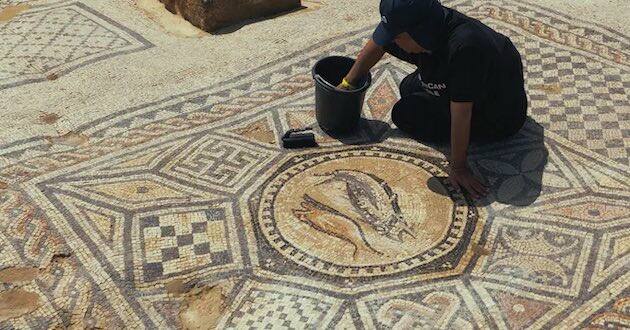The Museum of the Bible and the Israel Antiquities Authority have announced a new exhibit, The Megiddo Mosaic: Foundations of Faith, that features a decorative mosaic floor from one of the oldest sites of Christian worship.
“This is arguably one of the most important archaeological discoveries for understanding the early Christian church,” said Bobby Duke, interim chief curator at the museum. It contains the earliest known written name of Yeshua – Jesus, ever found
“The Megiddo mosaic represents the most significant archaeological find since the Dead Sea Scrolls,” Gil Lin, the head of the Megiddo Regional Council said. “This mosaic, nearly 1,800 years old, is the earliest known house of prayer and the first physical proclamation of Jesus Christ as God. For billions worldwide, it’s not merely an artifact but a tangible link to shared history, tradition and faith.”
“For example, the mosaic underscores the crucial role of women in the early church by the fact that five women are mentioned in it by name. Truly, the mosaic presents a wealth of new data for church historians, like the Dead Sea Scrolls did for Bible scholars.”
The Megiddo Mosaic, which dates to the third century, formed part of the floor of the oldest site of Christian worship ever discovered. The mosaic and the building containing it were uncovered 20 years ago by Yotam Tepper, Ph.D., from the Israel Antiquities Authority. It was discovered during a preconstruction archaeological dig in the Megiddo prison in Israel, as it was planned to build a new wing in the prison. Eventually, prisoners worked alongside the archaeologists to uncover the rare discovery.
According to Alegre Savariego, curator of the exhibition on behalf of the antiquities authority, “The mosaic presents groundbreaking physical evidence of the practices and beliefs of early Christians, including the first archaeological instance of the phrase, ‘God Jesus Christ.’ Also featured on the mosaic are one of the earliest examples of a fish being used as a Christian symbol and the names of several of the church’s patrons — a Roman centurion, an artist and five women.”
The conservation of the mosaic was done by the Conservation Department of the Israel Antiquities Authority. The mosaic was cleaned, its edges stabilized, and lacunae, or empty spaces, were filled in with mortar. Then, loose tesserae, the stone cubes that make up the mosaic, were grouted and re-laid on new supports.
The display is accompanied by artifacts discovered during its excavation, which offer a glimpse into daily life in the Roman Sixth Legion Ferrata. These items include roof tiles, an inscribed bread stamp, a bronze statuette of the Roman god of home Lar, engraved Carnelian intaglios, fragments of mortarium pottery with the Greek inscription “Peace and Luck” and coins.
More information is available at www.museumofthebible.org.
–Dwight Widaman








